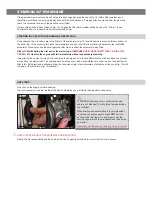
RUNNING IN OF THE ENGINE
Each client receives his paraengine with approx. 15-20 min. Of having been run in on the ground, where each unit
is regulated and carbureted at sea level. Also checked is that the propeller is perfectly balanced, as well as all the
components of the engine (clutch, redactor, etc.)
Before running in we recommend that it should be warmed up for 15 minutes. Above 5000 RPM. Before you begin to
fly with it (do not leave the engine in LOW REVS too much time because it GREASES IN EXCESS THE EXHAUST AND
SILENCER WHICH WILL PRODUCE MORE NOISE AND DRENCH THE FIBER OF THE INSIDE OF THE SILENCER (This
is the reason why the engine expels smoke in excess when having it in slow revs a few minutes and then accelerating.
During the first hours we should not abuse to a maximum RPM of the engine. The entire running in is considered after 10
hours of use of the engine (on ground and during flight).
Respecting the first 15 minutes, please do the rest of the hours flying. In the case of heavy pilots they are advised to do,
at least 1 hour on the ground before flying.
The optimal regime for good running in is to keep the engine between 6,000 to 7,500 RPM. From time to time rising
above the 7,500 RPM for a few seconds. The regime must vary frequently and in progressive increase. Not giving full gas
blows continuously, since the centrifugal clutch will be exposed to abnormal loads.
It is important, that after 1 or 2 hours of flight, we check the clamping screws of the cylinder head which must be
tightened using a wrench (see the table of corresponding wrench tightness). Usually when the cylinder head loosens we
can hear deaf ‘shotgun’ noises (heard when starting up the engine) or oil stains can be seen in its Union with the cylinder.
Revisions and checks during this phase are detailed in the maintenance section, (10 hours). If you notice symptoms of
power loss, it may be caused by a poor engine fuel due to the regulation or that the filter has been dirtied. It Is always more
desirable an engine with rich engine fuel than poor; at least we exclude risks of gripe...With the following table we can check
visually if the mixture (we refer to gasoline - air, not oil-gasoline) is poor or rich in function of the color of the spark plug.
COLOR OF SPARK PLUG
YELLOW / GREY
COFFEE WITH MILK
BROWN / BLACK
MOTOR FUEL
POOR
FAIR
RICH
THE PERCENTAGE OF OIL IN THE MIX WILL NEVER VARY AND IT WILL ALWAYS BE INDICATED ACCORDING
TO THE MODEL OF ENGINE, NEVER ADD MORE OIL AS INDICATED IN THIS TABLE NEITHER DURING THE
PHASE OF RUNNING IN.
We recommend Castrol Power 1 Racing.
Un motor bien rodado puede aumentar su vida útil en un 100% y minimizar los problemas mecánicos que se
puedan tener. En caso contrario tiene altas probabilidades de sufrir daños importantes en sus primeras horas,
que serán irreversibles para su vida útil.
ENGINES
Gasoline
Synthetic oil
RM80
Unleaded 98 or 95
2 per cent (100 ml per five liters of petrol)
PA125
Unleaded 98 or 95
2.5% (125 ml every 5 liters of gasoline)
1
2
3
Regulation screw low RPM;
Adjustment by default is 1 ½ turns
out from fully screwed in.
Idle screw
; It adjusts the idling regime opening choker plate
at is minimum. Adjust it while engine is hot and until it reaches
2100 – 2200 RPM.
Button to prime the carburetor (fig 17).
THIS IS THE FACTORY SETTING. UNDER NO
CIRCUMSTANCES SHOULD YOU MODIFY THIS
SETTING, TO OPEN IT OR TO CLOSE IT, AS THE RISK
IS HIGH OF DANGEROUSLY BORING A HOLE IN THE
PISTON.
1
2
3























